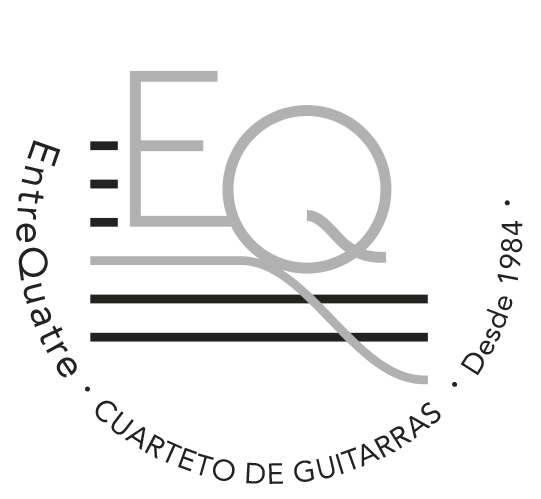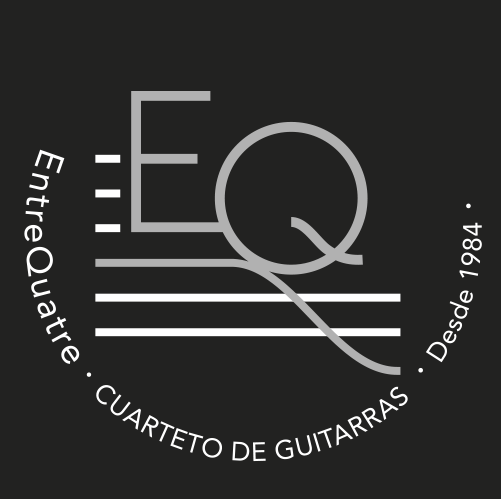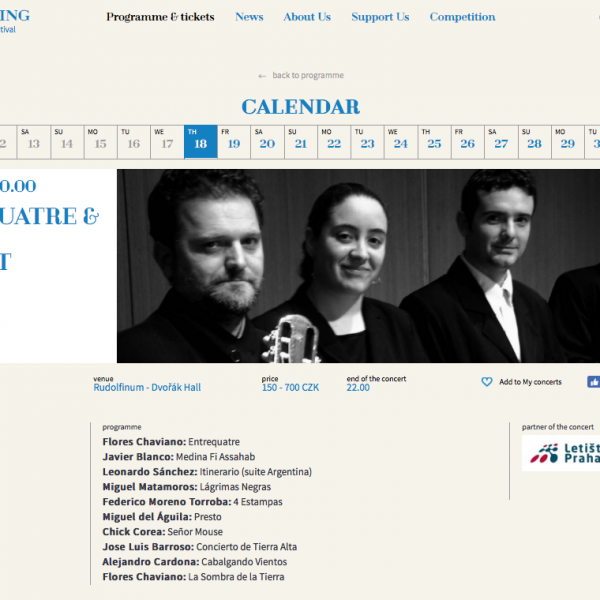Flores Chaviano (Caibarién, 1946) es el guitarrista-compositor cubano más universal de su generación. Establecido en España desde 1981, Chaviano ha actuado en medio mundo y ha impulsado y participado en numerosos cursos de guitarra contemporánea. La música popular cubana ha estado presente en su obra desde sus comienzos, mezclándose con toda suerte de técnicas experimentales en relación con su instrumento. En 1984 escribió su primera obra para EntreQuatre cuando el grupo ni siquiera tenía nombre, su título: Entrequatre. Quiso el autor que esa obra primeriza se sumergiera en ese mundo sonoro, a la vez primitivo y lúdico, de la música afrocubana que tanto le cautiva. Ése es terreno musical en el que Chaviano, pertrechado de escalas pentatónicas y sonoridades rituales, se mueve como pocos. En esta obra llega a convertir al cuarteto de guitarras en un ensamble de tambores Batá con un intermedio lento y atmosférico rodeado de dos pasajes rítmicos, lúdicos y vertiginosos.
Javier Blanco (Langreo, 1977) es un compositor autodidacta cuya formación musical se ha basado en la práctica de músicas de todo tipo, desde el Heavy Metal hasta la de verbenas de fiesta de pueblo, pasando por el jazz, el folk o el rock. La síntesis creativa de este autor con esta mezcla tan singular no podía ser anodina: su música se mueve en todos los ámbitos, también el sinfónico en el que maneja con enorme destreza el lenguaje cinematográfico. Sin embargo, en Medina Fi Assahab se queda en la sonoridad camerística para utiliza con enorme eficacia la técnica minimalista. Con esos mimbres concibe una música efectista y descriptiva de una ciudad imposible, flotante, inundada de ecos también imposibles que consiguen materializar lo etéreo.
Leonardo Sánchez nació en Argentina en 1966 donde realiza la primera parte de sus estudios hasta obtener el título de Profesor de Guitarra. Lleva a cabo la segunda en París donde se asienta definitivamente. Obtiene allí la licenciatura en Musicología, y en 1990 obtiene el Primer Premio de Guitarra nivel de «Excelencia» en Hauts-de-Seine. Intérprete, compositor y arreglista, ha colaborado en diversos proyectos musicales en Argentina y en Europa junto a grandes figuras latinoamericanas como Orlando Trípodi, Osvaldo Piro, o Mercedes Sosa. Como compositor escribe para formaciones diversas, como banda sinfónica, conjunto de acordeones y mandolinas, bandoneón solista y, en este caso, cuarteto de guitarras. En Itinerario, y con cuatro danzas, desgrana los cuatro puntos cardinales de Argentina; se presentan aquí dos de ellos, opuestos, Norte, un huayno próximo a las sonoridades andinas, y Sur, una milonga impresionante que retrata su condición de antecesora del tango.
Miguel Matamoros (Santiago de Cuba 1894-1971) es una de las figuras más importantes de ese movimiento popular tan significativo de Latinoamérica como es la Trova Santiaguera. Su influencia en las músicas y los músicos populares de todo el continente es indudable, pero también en otros muchos ámbitos de la creación musical, tanto del jazz como de la música culta. Flores Chaviano llegó a conocer a Miguel Matamoros en Santiago en el que fue su primer destino como profesor de guitarra; allí se imbuyó de aquella música que marcaría desde entonces toda su obra. Lágrimas Negras es todo un monumento, una obra maestra de la creación popular, tanto en la letra como en la música, era cuestión de tiempo que Chaviano pensara una versión para EntreQuatre en la que desgrana todo su conocimiento del instrumento y sin desperdiciar ninguna de sus posibilidades sonoras. Un homenaje a uno de los grandes de la música popular que han propiciado que esas sonoridades entren por la puerta grande en las grandes salas de conciertos.
Federico Moreno Torroba (Madrid 1891-1982) es uno de los últimos grandes compositores de zarzuela. En sus comienzos respondió con presteza a los requerimientos de Andrés Segovia y escribió un buen número de obras que enriquecieron el repertorio moderno de la guitarra. En la década de los 70 del siglo pasado dedicó especial atención a la música para cuarteto de guitarras, en este caso por encargo de los Hermanos Romero. A parte del tan interesante como poco programado Concierto Ibérico para cuatro guitarras y orquesta, Torroba compuso 4 obras, todas interesantes, pero la más emblemática es sin duda Estampas, ocho pequeñas páginas que recorren diversos paisajes españoles; en este concierto se presenta una selección de cuatro que demuestran la eficacia descriptiva del autor, no exenta de sentido del humor.
El uruguayo Miguel del Águila (Montevideo, 1957), estudió en los tres conservatorios de su ciudad natal, trasladándose posteriormente en 1978 a Los Angeles y completando su formación el el Conservatorio Superior de Viena antes de regresar definitivamente a Estados Unidos, donde inició una exitosa carrera como pianista, compositor y director de su propia música. Presto es, originalmente, el movimiento final de un cuarteto de cuerda escrito en sus años de estudio académico en la capital del Prater, transcrito luego para cuarteto de guitarras. Basada sobre un módulo rítmico-armónico constante que se repite casi sin variación del primer compás al último como una especie de perpetuum mobile, las fuertes síncopas y la frecuente presencia de la métrica irregular construyen un discurso sin fisuras en que la motricidad y la isocronía se manifiestan como el elemento esencial: de una energía contagiosa, la pieza sugiere constantemente tanto el jazz como diversos ritmos latinoamericanos, explorando con pertinencia múltiples formas de ataque guitarrístico.
Alejandro Cardona (San José, 1959) es guitarrista, instrumento al que ha destinado obras importantes de su catálogo, en el que hay música de orquesta y de cámara. Alumno en Harvard, se estableció en México en 1982, regresando a Costa Rica tres años más tarde. Desdeñoso, tanto de las vanguardias europeas como del pseudouniversalismo de la globalización ideológica, Cardona —que confiesa su devoción por la figura y la obra de Silvestre Revueltas— ha estudiado ampliamente la música afrocaribeña, mexicana y centroamericana. La música de los indios y la de los rituales de santería (pero también las diferentes tradiciones criollas) están presentes en su obra. Cabalgando vientos arranca sobre ingrávidas pedales de armónicos de las que surge un desfile de girones melódico-rítmicos de músicas diversas, del blues al funky: se trata de evocaciones minúsculas no desarrolladas (pero perfectamente identificables), no de citas literales ni de la menor complacencia neo-folclorista. Si te rindes al viento puedes cabalgar en él: la frase de Toni Morrison que sirve de exordio a la partitura explica perfectamente la intención de esta pieza magistral que, al margen de todo anclaje tonal, atraviesa múltiples paisajes sin dejarse atrapar por ninguno de ellos, en una especie de viaje sobre un torbellino de incesante fuerza polirrítmica.
El madrileño Luis Barroso (1960) estudió en el conservatorio superior de su ciudad. Profesionalmente, forma parte como guitarrista de la prestigiosa Orquesta de laúdes Roberto Grandío y ha acompañado a afamados cantantes ligeros. El Concierto de Tierra Alta es un encargo del Grupo Entrequatre. Se trata de una obra de planteamiento tripartito tradicional compuesta en un estilo tonal que recrea numerosos elementos del flamenco, pero sin condescender con ninguna cita literal. Se trata, más bien, de una evocación que utiliza ritmos y escalas modales con gran libertad muy bien integrados. Los acordes por cuartas y los rasgueos guitarrísticos característicos están empleados con gran discrección, dentro de una concepción compositiva muy cuidadosa en que se resalta y explota, sobre todo, el valor cantable de los solistas: de ahí la ocasional importancia del contrapunto. El melodismo está especialmente desarrollado en el movimiento lento, de estructura ternaria, cuya sección central se basa en un juego de hemiolias que anticipa la fuerte componente rítmica del movimiento de cierre. De una escritura extremadamente diáfana y precisa, la mayor virtud de la obra es su total ausencia de pretenciosidad y su expresividad directa.
La sombra de la tierra, de Flores Chaviano, es el segundo encargo escrito para el grupo Entrequatre para este programa. Se trata de una especie de toccata que funciona por transformación constante de un motivo único: una célula de cuatro notas que contiene una cuarta, una segunda y una tercera menores que se permuta, invierte y transforma de todas las formas posibles con un rigor casi serial para, manteniendo el ostinato de una pulsación única sobre un pié rítmico de un compás (una célula y su inversión libre), extraer de tan parco material toda suerte de consecuencias que se despliegan entre ambos cuartetos tanto por duplicaciones e imitaciones como de manera antifonal o por ocasionales hoquetus: el ritmo inicialmente cuadrado se desnaturaliza paulatinamente por la irrupción de síncopas y hemiolias para, tras una vertiginosa sección en seisillos y con una incisividad rítmica mantenida y subyugante, transformarse de modo progresivo para evocar de manera fugaz tanto el jazz o el son como una suerte de tumbao en que la pieza desemboca en una conclusión jadeante.




